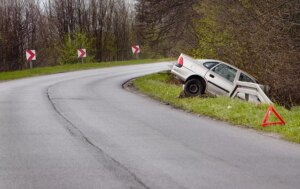What Are the Causes of Single Vehicle Accidents or Crashes?
 Not all car accidents involve more than one vehicle. Single vehicle accidents are frequent occurrences on Colorado’s roadways, for reasons ranging from unsafe roadways to animals crossing the road. Understanding how and why most single-vehicle auto accidents happen can help you stay safe on the roads. The following are some of the most common causes of motor vehicle crashes involving only one vehicle:
Not all car accidents involve more than one vehicle. Single vehicle accidents are frequent occurrences on Colorado’s roadways, for reasons ranging from unsafe roadways to animals crossing the road. Understanding how and why most single-vehicle auto accidents happen can help you stay safe on the roads. The following are some of the most common causes of motor vehicle crashes involving only one vehicle:
Drug and Alcohol Use
According to the Department of Transportation, drivers who have been drinking alcohol are almost 30% more likely to get into fatal single-vehicle accidents than sober drivers. Drug and alcohol use can make it difficult or impossible for a driver to safely control a vehicle. Intoxication also increases the risk of poor driver decision-making such as speeding or swerving. A drunk driver can get into a single-vehicle crash if he or she loses control of the vehicle and collides with a fixed object, runs off the road, or rolls over.
Speeding
Driving over posted speed limits or too fast for conditions can significantly increase the risk of a driver losing control of a vehicle. Driving “too fast for conditions” can qualify as speeding even if the driver is technically under the posted speed limit. It is up to the driver to use his or her best judgment to lower speed in dangerous conditions. Taking curves too fast can result in vehicle rollover accidents, while speeding on wet roads can lead to hydroplaning, spinning, and crashing into partitions or objects. It is also more difficult for a speeding driver to react to changing roadway conditions, such as an animal darting into the road, than someone who is obeying the speed limit.
Driver Distraction
In 2016, 3,450 people died in distracted driving crashes in the U.S. A driver can get into a single-vehicle wreck if something like a cell phone is distracting him or her from the driving task. Looking down at a cell phone to read a text, for example, can be enough to make a driver drift off the road and clip a median or divider. Common driver distractions include cell phones, eating and drinking, passengers, maps, GPS and radios, and personal grooming.
Driver Inexperience
A younger, less experienced driver may be more prone to involvement in single-vehicle accidents. Teen drivers do not have the experience to safely handle hazards such as potholes, animals, or wet asphalt. They may use inappropriate maneuvers such as jerking the wheel or slamming on the brakes, resulting in accidents. Inexperienced drivers are also more inclined to reckless driving, including speeding, alcohol use, cell phone use, and chatting with passengers.
Environmental Conditions
Sometimes, no matter how careful a driver is, roadway conditions prove too dangerous to safely maneuver. Many single-vehicle accidents in Colorado are weather-related. Snow, ice, sleet, fog, or heavy rain can all make the roadways unsafe and cause single-vehicle collisions. Rural roads pose special risks of accidents compared to urban roads, such as poor lighting, fallen trees in the roadway, and crossing animals. In 2016, 51% of all fatal crashes in the U.S. occurred on rural roads. This included 10,317 fatalities in single-vehicle crashes.
Roadway or Vehicle Defects
In some single-vehicle accidents, it is not the driver’s fault that the vehicle doesn’t perform as expected. Defective and dangerous auto parts such as bad brakes or tire blowouts can cause accidents involving only one vehicle. In these types of accidents, injured victims may be able to bring product liability claims against the at-fault manufacturer. Other single-vehicle accidents stem from another type of defect: roadway defects. Potholes, debris in the road, loose gravel, unsafe turns, fallen limbs, road collapses, and other defects can all cause single-vehicle accidents in Colorado. The government may be liable for accidents involving poor roadway conditions.